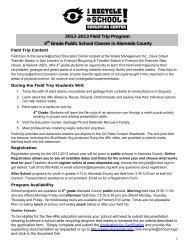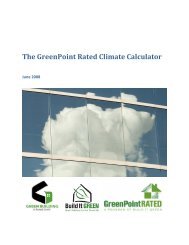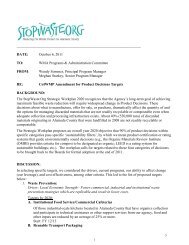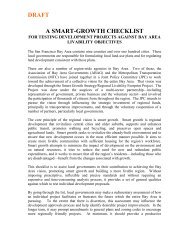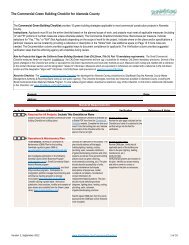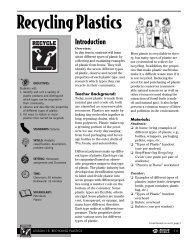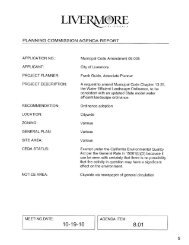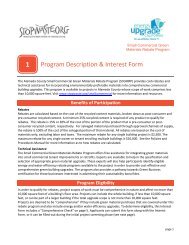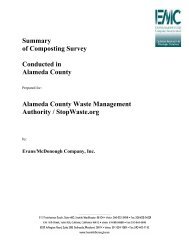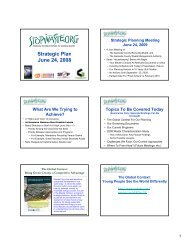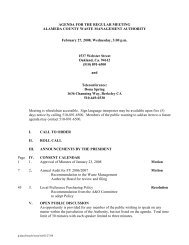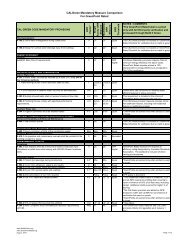Bay-Friendly Landscaping Principles and Practices - StopWaste.org
Bay-Friendly Landscaping Principles and Practices - StopWaste.org
Bay-Friendly Landscaping Principles and Practices - StopWaste.org
You also want an ePaper? Increase the reach of your titles
YUMPU automatically turns print PDFs into web optimized ePapers that Google loves.
<strong>Principles</strong><br />
& <strong>Practices</strong><br />
3. Prune selectively <strong>and</strong><br />
properly<br />
Description<br />
Pruning should complement the natural<br />
form <strong>and</strong> strengthen the structural<br />
integrity of the plant. It should not be<br />
used to dominate plants. The labor for<br />
this type of pruning is not a cost well<br />
spent; it never ends, weakens the plant<br />
<strong>and</strong> generates unnecessary plant debris.<br />
Applications<br />
n Use the st<strong>and</strong>ards from the American<br />
National St<strong>and</strong>ards Institute for proper<br />
tree pruning, including pruning at the<br />
appropriate time of year. Do not top<br />
trees but rather remove branches<br />
at their point of origin or shorten<br />
branches back to a lateral.<br />
n Prune when the plant is not under<br />
stress or dormant.<br />
n Ask your client to consider replacing<br />
a tree or shrub that requires frequent<br />
pruning because it has grown too large<br />
for its space with a species that will<br />
require little or no pruning.<br />
Benefits<br />
Trees <strong>and</strong> shrubs are stronger <strong>and</strong> more<br />
likely to resist pests. Waste is minimized.<br />
“Water use is<br />
an issue here<br />
in California.<br />
Plus, when you use a lot of<br />
water <strong>and</strong> fertilizer, that<br />
translates into green growth,<br />
more clippings, <strong>and</strong> more waste.<br />
If you can tell customers, ‘Let’s<br />
just fertilize once a year,’<br />
it reduces waste.”<br />
— Glen Schneider, Proprietor, Glen<br />
Schneider Gardening, Berkeley<br />
Damage to fencing from sprinkler irrigation.<br />
4. Water <strong>and</strong> fertilize<br />
judiciously<br />
Description<br />
Watering <strong>and</strong> fertilizing wisely prevents<br />
rampant plant growth that weakens the<br />
plants <strong>and</strong> generates plant debris.<br />
Applications<br />
There are many applications. Refer to<br />
Nurture the Soil <strong>and</strong> Conserve Water for<br />
more info.<br />
Benefits<br />
Plants are not pushed into growth<br />
over- drive. Water damage to fences<br />
<strong>and</strong> hardscapes is minimized. Waste<br />
is prevented <strong>and</strong> disposal bills are<br />
decreased. Less maintenance translates<br />
into lower labor <strong>and</strong> fuel costs.<br />
photo: the Municipal Water District of Orange County, L<strong>and</strong>scape Management for Water Savings<br />
by Tom Ash<br />
Prune selectively <strong>and</strong> avoid lopping. Adapted from<br />
illustration by Craig Farnsworth in Sustainable L<strong>and</strong>scape<br />
Construction.<br />
Sample Contract Specifications for Pruning:<br />
1. Trees <strong>and</strong> shrubs shall be pruned selectively only as necessary to<br />
enhance their natural shape. Topping of trees is prohibited except<br />
for safety or liability issues.<br />
2. Hedges<br />
a. Shearing new hedges into formal shapes is prohibited. Plants<br />
shall instead be selectively pruned by cutting individual branches or<br />
stems to interior lateral branches at appropriate locations, on an as<br />
needed basis.<br />
b. Existing hedges that have been maintained by shearing in the<br />
past <strong>and</strong> that do not have adequate space to grow to mature plant<br />
size, can continue to be maintained by shearing, until replacement is<br />
possible.<br />
3. Trimmings generated by pruning shall either be chipped <strong>and</strong> used<br />
as mulch on the site, or separated for plant debris recycling.<br />
FROM BAY-FRIENDLY LANDSCAPING MODEL MAINTENANCE SPECIFICATIONS,<br />
WWW.BAYFRIENDLY.ORG.<br />
24<br />
3



